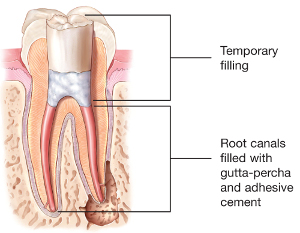Despite being one of the most common dental treatments, there are a lot of misconceptions surrounding root canal. Many people believe that perhaps they don’t need a root canal and they’d rather have their tooth extracted. This belief mainly stems from another misconception about root canal i.e. it’s too painful and has a lot of long term complications. Well, neither of it is true; in fact, root canal is one of the most effective dental treatments and proves to be extremely beneficial in the long run.
What kind of teeth need root canal?
Out teeth may seem tough on the surface, but beneath our tough white teeth lies a soft pulp called dentin. The outer tough portion of our teeth called enamel is basically there to protect the dentin. The dentin along with a network of nerves is underneath the crown of every tooth which is covered by the enamel. The nerves extend down to our gums. A root canal is performed in a situation where inflammation occurs in the pulp of the tooth. The inflammation may happen due to variety of reasons but the main reason is a bacterial infection. If an infected pulp, if left untreated, can not only cause immense pain, but may also lead to a formation of an abscess. The infection may also spread to other teeth and cause a severe swelling of the gums.
Bad oral hygiene, smoking, consuming too alcohol and caffeine or eating sugary and acidic foods may soften the enamel, making the pulp vulnerable to a bacterial attack. The weakened enamel may lead to the chipping off of the crown, further exposing the pulp. Too much pressure on the teeth that may be due to eating hard foods may also weaken the enamel.
What happens in a root canal?
The main purpose of the root canal is to extract the infected pulp and clean the inner part of the tooth. Basically, the idea is to heal the tooth instead of removing it. First, the crown of the tooth is removed, then the faulty pulp is extracted, the tooth is deep cleansed and the hollow part is filled with a gum like material called Gutta Percha and is covered by a synthetic crown. Sounds painful? Well, it’s actually not. Rensselaer Dentists make sure that your root canal is as pain free as possible. The patient is injected with anesthesia during the procedure and the entire process is carried out with a lot of meticulousness and care. Generally, the patient may feel a little soreness after the procedure, but that quickly goes away with a good anti inflammatory medicine and a pain killer.
Sometimes, if the procedure is not done carefully and the infected pulp remains, the patient may feel a lot of pain. But, at Rensselaer family dental center, the dentists make sure that the tooth is completely cleaned before filling it in and replacing it with a crown. The crown that is used is made to fit with the rest of the teeth of the patient. This is done by first taking the teeth impression of the patient and designing the crown accordingly. Once the crown is placed, it is secured with a permanent adhesive agent so that it does not come off. After the procedure is done, the tooth continues to function like a normal tooth.
Why go for root canal?
As opposed to extraction, root canal rescues the tooth and helps it restore its normal function. Root canal also ensures that the infected portion is effectively removed so that the infection does not spread. It also keeps your jaw intact by letting you keep all your teeth. Overall, root canal is a highly effective method which is ideal for severely infected teeth. Our dentists highly recommend it for anyone who is suffering from a severe tooth infection.

